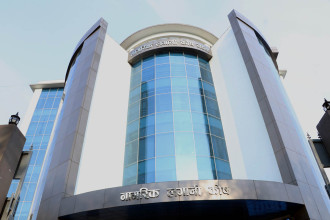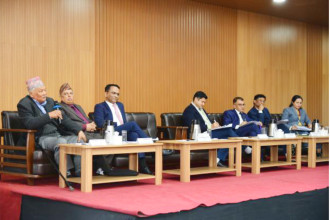
KATHMANDU: Nepal Rastra Bank has issued the country's macroeconomic and financial situation report based on eight months’ data ending mid-March, 2021/22.
Inflation Consumer Price Inflation As per report prepared by the central bank's Economic Research Department the year-over -year (y-o-y) consumer price inflation stood at 7.14% in the eighth month of 2021/22 compared to 3.03% a year ago. The food and beverage inflation stood at 7.51% whereas non-food and service inflation stood at 6.84% in the review month. Likewise, the prices of ghee and oil, vegetable, milk products and eggs and pulses & legumes sub-categories rose by 26.34%, 13.96%, 11.30% and 10.30% respectively on y-o-y basis. In the review month, the Kathmandu Valley, Tarai, Hill and Mountain regions witnessed 6.31%, 7.36%, 7.69% and 7.56%. Inflation in these regions was 2.50%, 3.25%, 3.40% and 1.31% respectively a year ago. Wholesale Price Inflation The y-o-y wholesale price inflation stood at 13.13% in the review month compared to 6.30% a year ago. The y-o-y wholesale price of consumption goods, intermediate goods and capital goods increased by 15.04%, 12.99% and 7.61% respectively. The wholesale price of construction materials increased 24.24% in the review month. Salary and Wage Rate Index The y-o-y salary and wage rate index increased 7.26% in the review month. Such a growth rate was 1.89% a year ago. In the review month, salary index and wage rate index increased 9.44 and 6.64%, respectively.
Remittances Remittance inflows decreased 1.7% to Rs 631.19 billion in the review period against an increase of 8.7% in the same period of the previous year. In the US Dollar terms, remittance inflows decreased 3.0% to 5.29 billion in the review period against an increase of 5.0% in the same period of the previous year. The number of Nepali workers (institutional and individual-new and legalised) taking approval for foreign employment increased significantly to 227,900 in the review period. It had decreased 82.9% in the same period of the previous year. The number of Nepali workers (Renew entry) taking approval for foreign employment increased 240.9% to 178,262 in the review period. It had decreased 70.2% in the same period of the previous year. Net transfer decreased 2.0% to Rs 704.33 billion in the review period. Such a transfer had increased 7.2% in the same period of the previous year.
Foreign Exchange Reserves Gross foreign exchange reserves decreased 16.3% to Rs 1,171 billion in mid-March 2022 from Rs 1,399.02 billion in mid-July 2021. In US Dollar terms, the gross foreign exchange reserves decreased 18.5% to 9.58 billion in mid-March 2022 from 11.75 billion in mid-July 2021. Of the total foreign exchange reserves, reserves held by NRB decreased 18.2% to Rs 1018.05 billion in mid-March 2022 from Rs 1,244.63 billion in mid-July 2021. Reserves held by banks and financial institutions (except NRB) decreased 0.9%% to Rs 152.95 billion in mid-March 2022 from Rs154.39 billion in mid-July 2021. The share of Indian currency in total reserves stood at 24.2% in mid-March 2022. Foreign Exchange Adequacy Indicators Based on the imports in eight months of 2021/22, the foreign exchange reserves of the banking sector is sufficient to cover the prospective merchandise imports of 7.4 months, and merchandise and services imports of 6.7 months. The ratio of reserves-to-GDP, reserves-to-imports and reserves-to-M2 stood at 27.4%, 55.6% and 22.0% respectively in mid-March 2022. Such ratios were 32.8%, 84.7% and 27.1% respectively in mid-July 2021.
Monetary Situation Money Supply Broad money (M2) increased 3.1% in the review period compared to the growth of 11.4% in the corresponding period of the previous year. On y-o-y basis, M2 expanded 12.7% in mid-March 2022. The net foreign assets (NFA after adjusting foreign exchange valuation gain/loss) decreased Rs 258.64 billion (19.4%) in the review period compared to an increase of Rs 68.0 billion (5.1%) in the corresponding period of the previous year. Reserve money decreased 14.4% in the review period compared to an increase of 10.5% in the corresponding period of the previous year. On y-o-y basis, reserve money increased 0.6% in mid-March 2022. Domestic Credit Domestic credit increased 10.5% in the review period compared to an increase of 13.0% in the corresponding period of the previous year. On y-o-y basis, domestic credit increased 24.3% in mid-March 2022. Monetary Sector's claims on the private sector increased 13.9% in the review period compared to an increase of 17.5% in the corresponding period of the previous year. On y-o-y basis, such claims increased 22.5% in mid-March 2022. Deposit Mobilisation Deposits at Banks and Financial Institutions (BFIs) increased 4.1% in the review period compared to an increase of 11.0% in the corresponding period of the previous year. On y-o-y basis, deposits at BFIs expanded 14.0% in mid-March 2022. The share of demand, saving, and fixed deposits in total deposits stand at 8.4%, 29.1% and 55.5% respectively in mid-March 2022. Such shares were 8.4%, 34.5% and 48.6% respectively a year ago. The share of institutional deposits in the total deposit of BFIs stands at 38.8% in mid-March 2022. Such a share was 42.1% in mid-March 2021. Credit Disbursement Private sector credit from BFIs increased 12.8% in the review period compared to an increase of 17.4% in the corresponding period of the previous year. On y-o-y basis, credit to the private sector from BFIs increased 22.2% in mid-March 2022. In the review period, private sector credit from commercial banks, development banks and finance companies increased 12.4%, 14.0% and 25.2% respectively. In the review period, out of the total outstanding credit of the BFIs, 67.0% is against the collateral of land and building and 12.5% against the collateral of current assets (such as agricultural and non-agricultural products). Such ratios were 66.2% and 12.3% respectively a year ago. Outstanding loan of BFIs to the agriculture sector increased 16.1%, industrial production sector 9.8%, transportation, communication and public sector 9.2%, wholesale and retail sector 14.7% and service industry sector 7.4% in the review period. In the review period, term loan extended by BFIs increased 13.1%, overdraft 21.4%, demand and other working capital loan 15.6%, real estate loan (including residential personal home loan) 14.1% and hire purchase loan 5.0% while that of trust receipt (import) loan decreased 41.9% and margin nature loan 9.9%. READ ALSO:
Inflation Consumer Price Inflation As per report prepared by the central bank's Economic Research Department the year-over -year (y-o-y) consumer price inflation stood at 7.14% in the eighth month of 2021/22 compared to 3.03% a year ago. The food and beverage inflation stood at 7.51% whereas non-food and service inflation stood at 6.84% in the review month. Likewise, the prices of ghee and oil, vegetable, milk products and eggs and pulses & legumes sub-categories rose by 26.34%, 13.96%, 11.30% and 10.30% respectively on y-o-y basis. In the review month, the Kathmandu Valley, Tarai, Hill and Mountain regions witnessed 6.31%, 7.36%, 7.69% and 7.56%. Inflation in these regions was 2.50%, 3.25%, 3.40% and 1.31% respectively a year ago. Wholesale Price Inflation The y-o-y wholesale price inflation stood at 13.13% in the review month compared to 6.30% a year ago. The y-o-y wholesale price of consumption goods, intermediate goods and capital goods increased by 15.04%, 12.99% and 7.61% respectively. The wholesale price of construction materials increased 24.24% in the review month. Salary and Wage Rate Index The y-o-y salary and wage rate index increased 7.26% in the review month. Such a growth rate was 1.89% a year ago. In the review month, salary index and wage rate index increased 9.44 and 6.64%, respectively.
Remittances Remittance inflows decreased 1.7% to Rs 631.19 billion in the review period against an increase of 8.7% in the same period of the previous year. In the US Dollar terms, remittance inflows decreased 3.0% to 5.29 billion in the review period against an increase of 5.0% in the same period of the previous year. The number of Nepali workers (institutional and individual-new and legalised) taking approval for foreign employment increased significantly to 227,900 in the review period. It had decreased 82.9% in the same period of the previous year. The number of Nepali workers (Renew entry) taking approval for foreign employment increased 240.9% to 178,262 in the review period. It had decreased 70.2% in the same period of the previous year. Net transfer decreased 2.0% to Rs 704.33 billion in the review period. Such a transfer had increased 7.2% in the same period of the previous year.
Foreign Exchange Reserves Gross foreign exchange reserves decreased 16.3% to Rs 1,171 billion in mid-March 2022 from Rs 1,399.02 billion in mid-July 2021. In US Dollar terms, the gross foreign exchange reserves decreased 18.5% to 9.58 billion in mid-March 2022 from 11.75 billion in mid-July 2021. Of the total foreign exchange reserves, reserves held by NRB decreased 18.2% to Rs 1018.05 billion in mid-March 2022 from Rs 1,244.63 billion in mid-July 2021. Reserves held by banks and financial institutions (except NRB) decreased 0.9%% to Rs 152.95 billion in mid-March 2022 from Rs154.39 billion in mid-July 2021. The share of Indian currency in total reserves stood at 24.2% in mid-March 2022. Foreign Exchange Adequacy Indicators Based on the imports in eight months of 2021/22, the foreign exchange reserves of the banking sector is sufficient to cover the prospective merchandise imports of 7.4 months, and merchandise and services imports of 6.7 months. The ratio of reserves-to-GDP, reserves-to-imports and reserves-to-M2 stood at 27.4%, 55.6% and 22.0% respectively in mid-March 2022. Such ratios were 32.8%, 84.7% and 27.1% respectively in mid-July 2021.
Monetary Situation Money Supply Broad money (M2) increased 3.1% in the review period compared to the growth of 11.4% in the corresponding period of the previous year. On y-o-y basis, M2 expanded 12.7% in mid-March 2022. The net foreign assets (NFA after adjusting foreign exchange valuation gain/loss) decreased Rs 258.64 billion (19.4%) in the review period compared to an increase of Rs 68.0 billion (5.1%) in the corresponding period of the previous year. Reserve money decreased 14.4% in the review period compared to an increase of 10.5% in the corresponding period of the previous year. On y-o-y basis, reserve money increased 0.6% in mid-March 2022. Domestic Credit Domestic credit increased 10.5% in the review period compared to an increase of 13.0% in the corresponding period of the previous year. On y-o-y basis, domestic credit increased 24.3% in mid-March 2022. Monetary Sector's claims on the private sector increased 13.9% in the review period compared to an increase of 17.5% in the corresponding period of the previous year. On y-o-y basis, such claims increased 22.5% in mid-March 2022. Deposit Mobilisation Deposits at Banks and Financial Institutions (BFIs) increased 4.1% in the review period compared to an increase of 11.0% in the corresponding period of the previous year. On y-o-y basis, deposits at BFIs expanded 14.0% in mid-March 2022. The share of demand, saving, and fixed deposits in total deposits stand at 8.4%, 29.1% and 55.5% respectively in mid-March 2022. Such shares were 8.4%, 34.5% and 48.6% respectively a year ago. The share of institutional deposits in the total deposit of BFIs stands at 38.8% in mid-March 2022. Such a share was 42.1% in mid-March 2021. Credit Disbursement Private sector credit from BFIs increased 12.8% in the review period compared to an increase of 17.4% in the corresponding period of the previous year. On y-o-y basis, credit to the private sector from BFIs increased 22.2% in mid-March 2022. In the review period, private sector credit from commercial banks, development banks and finance companies increased 12.4%, 14.0% and 25.2% respectively. In the review period, out of the total outstanding credit of the BFIs, 67.0% is against the collateral of land and building and 12.5% against the collateral of current assets (such as agricultural and non-agricultural products). Such ratios were 66.2% and 12.3% respectively a year ago. Outstanding loan of BFIs to the agriculture sector increased 16.1%, industrial production sector 9.8%, transportation, communication and public sector 9.2%, wholesale and retail sector 14.7% and service industry sector 7.4% in the review period. In the review period, term loan extended by BFIs increased 13.1%, overdraft 21.4%, demand and other working capital loan 15.6%, real estate loan (including residential personal home loan) 14.1% and hire purchase loan 5.0% while that of trust receipt (import) loan decreased 41.9% and margin nature loan 9.9%. READ ALSO:
Published Date: April 14, 2022, 12:00 am
Post Comment
E-Magazine
RELATED B360 National





